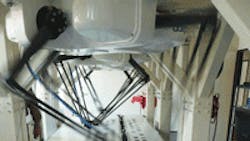The future of food processing has little room for the human touch. At least that's the future according to a growing number of robot manufacturers, who say that recent advances in robotic technology, along with FDA approval of particular models, has opened the door to a fully automated system handling what we eat.
Long limited to just working in warehouses doing palletizing and case packing due to hygiene concerns and high upfront investment, robots were on wide display during April's Anuga FoodTec Conference held in Cologne, Germany.
The biannual exhibition showcased 20 robot manufacturers pooling together and creating a sausage processing line -- all automated. Meat was sent into a hopper at one end and came out the other fully palleted and wrapped for transport.
Adept's Quattro s650HS can process 300 pieces per minute.
Similarly, Adept Technologies, a manufacturer of industrial robots, shipped the industry's first USDA-accepted parallel robot for meat and poultry processing in March. The robot systems were sent to several unnamed food handling companies for high-speed hygienic handling.
Why is this significant from a broader perspective? Because according to Rush La Selle, director of worldwide sales and marketing for Adept Technologies, robots aren't just being asked to pick and place uniform objects. They are now taking on more complex tasks -- and can do so while maintaining the highest hygienic standards.
In the food industry, for instance, chicken breasts vary from piece to piece. Through integrated vision and line tracking, the robot can identify and locate each piece, place it for packaging and do so at dizzying speeds. Adept's Quattro s650HS, for example, can process 300 pieces per minute.
"The technology is now to a place where the robot through sensory technology should be able to act in the same way a person does in adjusting, fitting and customizing their work," says La Selle. "Robots now have the ability to adapt to their environment and utilize tremendously vast amounts of information. That's why I believe robots are going to be a bridge between the digital and the physical."
